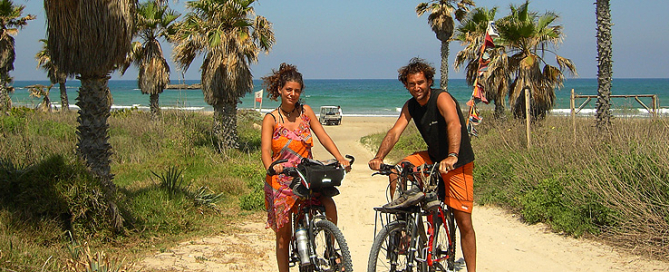Tel Aviv
From Jerusalem we cycled going down to Tel Aviv, it was about 80 km which separate the capital city to the centre of the Israeli global economy.
When we arrived we stayed in one of its most economic hotels, anyway we paid 40 u$s per night, a very different price to which we weren’t used to pay in any Arab countries from where we were coming. Few days later we met Guy and Yonatan, two Israelis students who invited us to their house. And we enjoyed it. Guy, Jewish son, was born
in Israel, but his family had emigrated from Iraq after the creation of the new Jewish state in 1950. According to Guy, in 606 B.C., the Babylonians conquered the Kingdom of Judah and transferred the Jews leaders to Babylon. Seventy years later, the Persian King “Ciro II, the Big One” allowed to the Jews to return to the Israel land but some people stayed and the Jewish community of Baghdad has been existing until the XX century, when the state of Israel was created definitively.
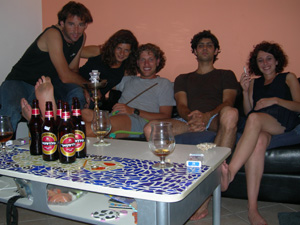
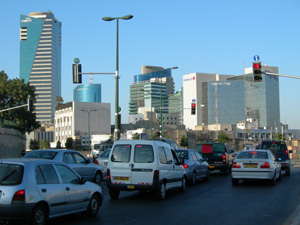
Yonatan had also been born in Israel, but he had lived several years in different countries, two of them in Argentina, which let to him to talk a good Spanish; and I really enjoyed it. According to him, after concluding the secondary school he entered the army where he remained 6 years, the last 3 because he chose it. According to the selective politics of his military government, his work consisted on demolishing with explosive the houses where the family of the responsible suicidal acts resided; who were always discovered by an elite command. “It is incredible”, he told me, “there are some mothers who bless her children before to commit a suicidal act”. Yonatan also told me that during all his permanency in the army never killed anybody.
Lisa, a Russian girl, also lived there; she had immigrated to Israel with her Jewish family in 1997. And we were surprised when small as she is, she told us: “I had also served the army, but as every woman only 2 years”.
Due to the Law of Return (which grants residence and citizenship to the Jews of any place of the world), Tel Aviv is today a mix of Jewish groups from diverse languages and cultures united by a national flag. But in spite of the last conflicts, as the second war with Lebanon, till today, Jewish descendants continue arriving in all Israel.
According to the boys, in 1948, when the new State was created, the total population in Israel was only 900.000 inhabitants, which 16% was non Jew. But between 1948 and 1960 the Jewish immigrant population increased in a million people more; they were emigrated from Muslim countries fearing the reprisals for the foundation of the new State of Israel; they came from Yemen, Iraq, Syria, Lebanon, Tunisia, Morocco, Libya, Iran and Algeria. The small Jewish community of Europe also immigrated to the new State after the Holocaust, they were less than a quarter of million of people. And after the fall of the Soviet Union other groups immigrated to Israel, (who were denied the permission of emigrating until that moment) they were from Russia, Ukraine and Byelorussia. As well as many Jews from Argentina after the economic crisis that have suffered in the last years.
Israel is a small country, with a population of 7 million inhabitants (2005); of which 78% is Jewish, and 19% Arab. In the same year the population in the West Bank and Jerusalem was of 2,3 millions. According to the Israeli Ministry of the Interior about 200.000 Jews settlers live in the Israeli settlements in the territories in dispute.
The immigration influenced notably in the demographic balance and in the economic development of Israel, also generating a positive growth thanks to the quantity of new immigrants with good academic level in all the branches of the science and the technology. Today Tel Aviv is the example city of the modernity in Israel, the industrial, commercial, financial and cultural centre of the country. It is also the gay capital of Middle East, where every year is celebrated the gay pride parade.
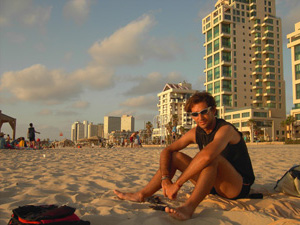
We stayed in Tel Aviv during more than three weeks, in which I looked for some sponsors. But it is the first time along my entire trip that I stop in a capital city to look for some sponsors and I left the country without any economic support; in spite of the so many meetings with important people. Anyway I earned some money with the sale of my dolls during the weekends. But it was funny, because except very few times, all the sales were one by one. Something that never happened to me, because their price is the same one to an ice cream.
One day, through Fran, an Argentinean friend, I went to the biggest bicycle shop of the country, where his owner after knowing about me, requested me the writing proposal in which I asked a new bicycle. My old bicycle already had 50.000 km. After some days I knew that the offer to my demand was the 30 % discount on a new bicycle. But the responsible of the shop had a new bicycle and he presented it to me. He didn’t interest in any kind of publicity, in spite of the fact that the main newspaper of the country and a bicycle magazine published an articulate about the trip.
Few days later another bicycle brand presented a bicycle to Clara, we were lucky.
The kibbutz
We left Tel Aviv toward the north, with our new bicycles, and in spite of the fact that the distance to Haifa was only of 80 km, we took several days to know different places and to enjoy all those sunsets which their beaches offered us. So we visited Herzilya, Hadera and Netanya; and we also stopped in the Ga’ash and Ma’agan Michael kibbutzes.
According to people who explained to us, in the last quarter of the XIX century, when the Ottoman Empire was still the owner of the Middle East and there was not Arab nationalism, (arisen newly in Syria at the beginning of the XX century) most of the territories that today are Israel were a desert. So in 1903 the Zionist movement, (a national liberation movement of the Jewish people) bought to the Arab landowners, who resided in Beirut and Damascus, their poor Palestinian lands to erect the first kibbutz in a legal way. Therefore the kibbutzes were the first communities that became essential for the creation of the state of Israel. They were founded in a moment in which the independent agriculture was not practical. Forced by the necessity to develop a type of communal life and inspired by their own ideology Zionist socialist, the members of the kibbutz developed a way of life that has lasted several generations. However today they are living a transformation process that questions the validity of the kibbutz like a socialist and alternative way of life to the Establishment.
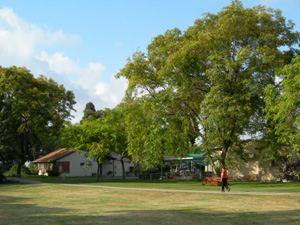
At the Ma’agan Michael kibbutz we met Roni who invited us to stay some days, because according to him, we only could stay if we were invited by a kibbutz member. For it, we camped on the beach, a fabulous place where we stayed almost one week. And when we were hungry we went to the restaurant where the food was delicious and the bills to pay insignificants; one of the so many advantages for the kibbutz members that Clara and I could also enjoy.
The kibbutz seemed a deluxe hotel, with an impressive swimming pool, football, basketball and tennis grounds, several aquatic sports and horses. We felt like in a hotel. According to Roni the Ma’agan Michael is one of most developed kibbutz from Israel which not only depends on the agriculture, it has the biggest plastic industry of the country, as well as a fish hatchery with commercial purpose and a great stable among other things. But also it has a very particular politics.
According to who explained to me every kibbutz members have a basic and equitable salary and most of the work positions are rotational; but if a member works outside the kibbutz he also has the same salary, because his real salary have to be donated for the community. For them all the goods are property of the kibbutz and they belong to all the members, as well as the services and the means of production.
We also knew that if a kibbutz member marries with a person no member, the kibbutz presents him a certain quantity of money, but if he marries with another kibbutz member, he will receive the double. Another of the advantages is that all the 18 years old members have an available house to live alone.
During our stay in Ma’agan Michael we knew a dozen of Argentinean boys who arrived to Israel after the aliyah, (the return to Israel for Jewish people). According to them, the kibbutz receives them for 6 months where they work and study Hebrew; and then the Israeli government offers them certain facilities to remain in the country. “We grew up in a Jewish community since child”, Ariel told me, “we were educated in a Jewish school, we attended to the Jewish parties and we always respected the Jewish calendar. Also in Buenos Aires several of us were leaders of young’s groups with Jewish origin. For us to come to Israel, doesn’t symbolize only to return to our mother land, but it represents the most important step in the long way to the search of our identity”.
In the north
On the way to Nazareth, we stopped in Eilabun, where we met to Ramez and his family and where we stayed some days. According to Ramez, Eilabun is a town in which its people are principally Arab Christian. But after the creation of the new state of Israel in 1948, the Israeli Military Force arrived and kicked its inhabitants out who already lived there since several generations. According to Ramez, many people rebelled against such measure, but as result 12 men were taken at random and executed, as the warning to the rest of the people. Years later, through several initiatives from UN and through a priest who stayed in the area, several families from that expulsion could return to their homes. One of them was the Ramez’s family.
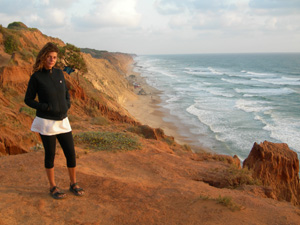
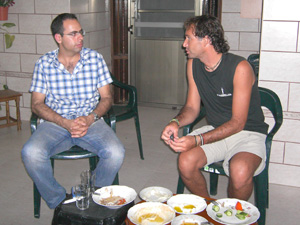
After some days we arrived in Nazareth, the biggest Arab city in Israel which has a population of 60.000 inhabitants, which 30% is Christian. There we stayed in a convent of nuns and then we visited the Basilica of the Annunciation, where according to the Roman Catholic tradition, it is the place where the angel Gabriel appeared to Maria; the San José’s Franciscan Church built on a grotto which was identified as Joseph’s carpentry, and we also visited the Synagogue, the supposed place in which Jesus taught. Today all of them are pilgrimage places.
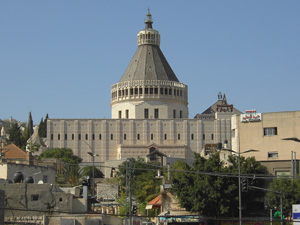

In the last days we visited Fran and his family who gave me the right contact from where I got my new bicycle. Fran lives in Nahariya, in the north of the country, to 40 km of the frontier with the Lebanon, a city which still keeps the sequences of the war with the Lebanon in 2006. But the most impacting was to know his house, because it has a bomb-proof refuge with iron doors of 20 centimetres wide. “Something very normal in the Israelis houses”, he told me.


